Language and Culture Date: 1 May 2009





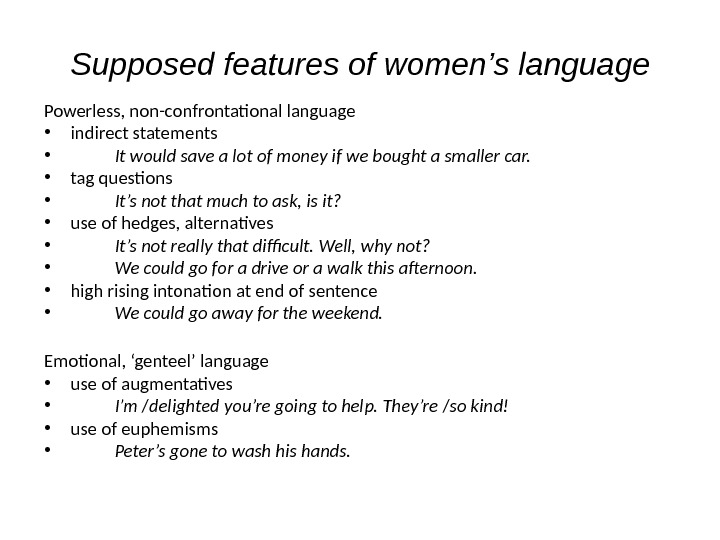

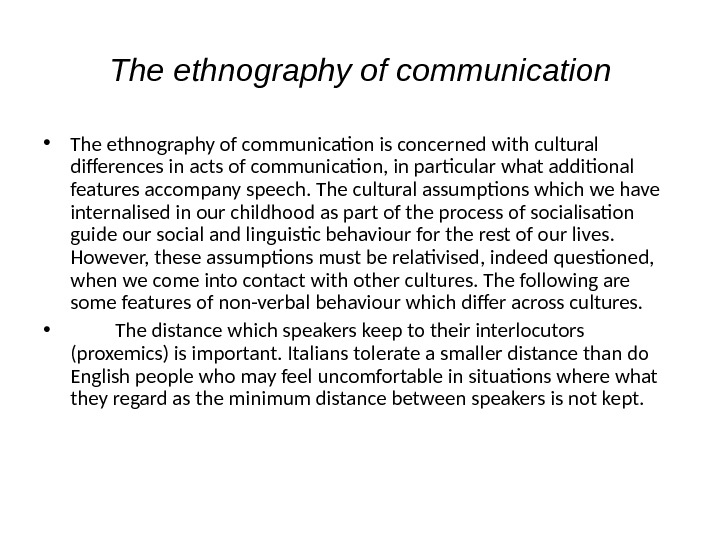
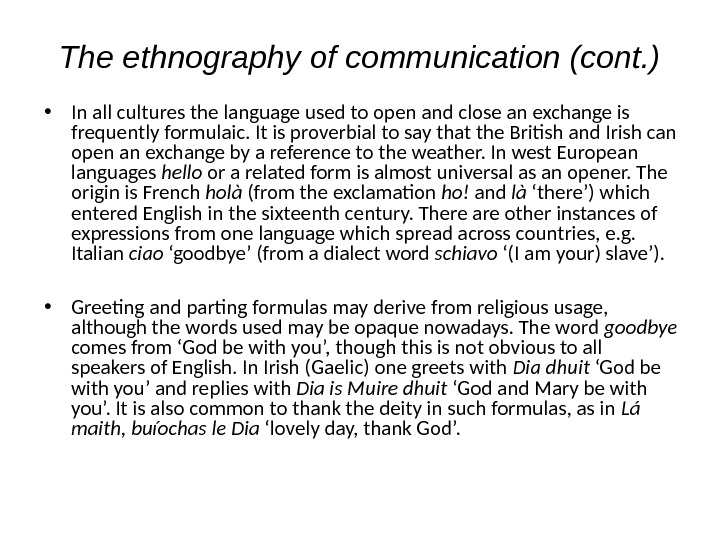

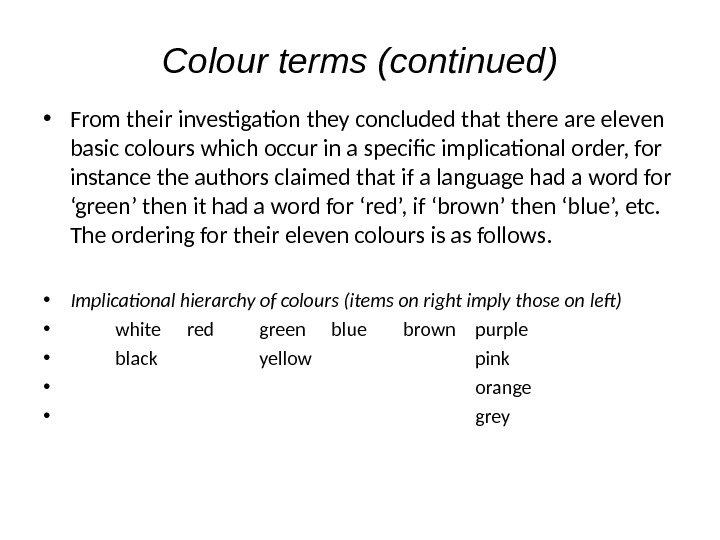
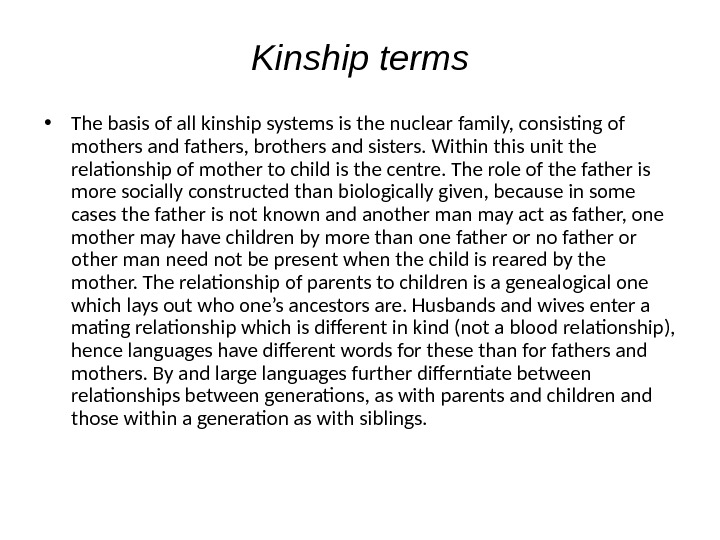
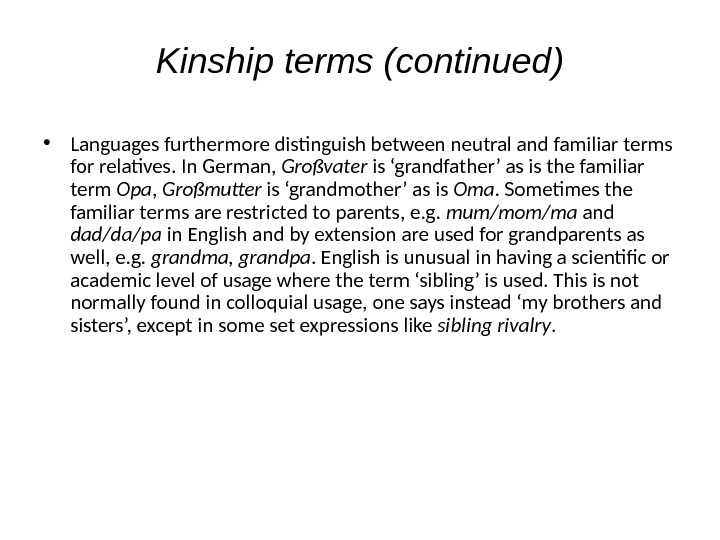
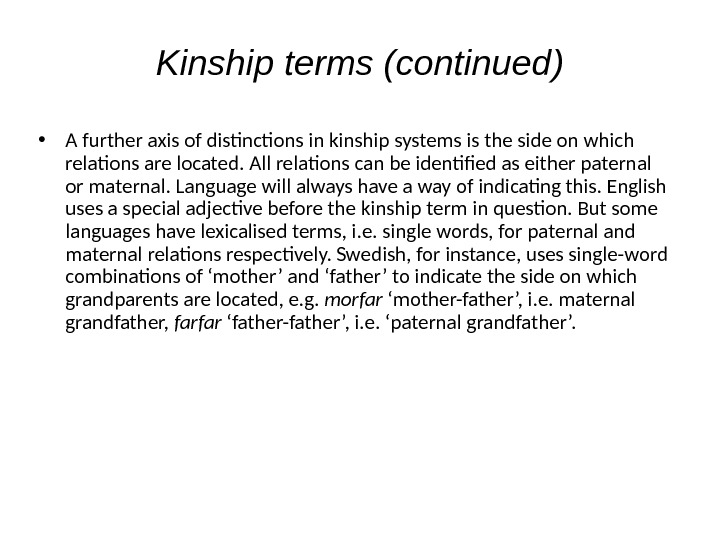

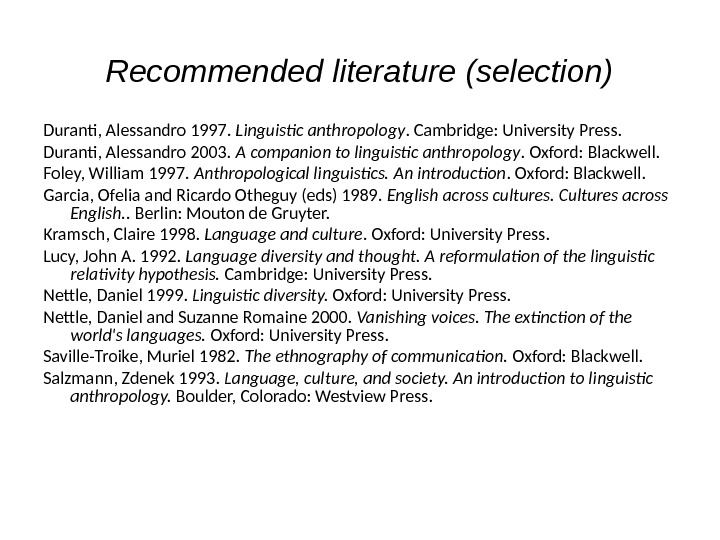
- Размер: 138 Кб
- Количество слайдов: 15
Описание презентации Language and Culture Date: 1 May 2009 по слайдам
 Language and Culture Date: 1 May
Language and Culture Date: 1 May
 Various aspects of language and culture 1) Language and gender 2) The ethnography of communication 3) Colour terms 4) Kinship terms 5) Counting systems
Various aspects of language and culture 1) Language and gender 2) The ethnography of communication 3) Colour terms 4) Kinship terms 5) Counting systems
 Language and gender • The word ‘gender’, originally a grammatical term, has come to refer to the social roles and behaviour of individuals arising from their classification as biologically male or female. This is a huge complex embracing virtually all aspects of social behaviour of which language is only one. In the past three decades or so intensive research has been carried out into the relationship of language and gender, largely by female scholars who have felt drawn to the topic because of the obvious discrimination against women which has taken place in the past and which is still to be observed today.
Language and gender • The word ‘gender’, originally a grammatical term, has come to refer to the social roles and behaviour of individuals arising from their classification as biologically male or female. This is a huge complex embracing virtually all aspects of social behaviour of which language is only one. In the past three decades or so intensive research has been carried out into the relationship of language and gender, largely by female scholars who have felt drawn to the topic because of the obvious discrimination against women which has taken place in the past and which is still to be observed today.
 Language and gender (continued) • It is in the nature of language and gender studies that they are concerned with contrasting language as use by men and by women. Various opinions emerged on this relationship with two gaining particular focus. One is the difference approach which established that male and female language is dissimilar without attributing this to the nature of the social relationship between men and women. The other is the dominance approach which saw language use by females and males as reflecting established relationship of social control of the latter over the former. With the maturation of research on language and gender the simple ‘difference – dominance’ dichotomy was increasingly regarded as unsatisfactory and insufficiently nuanced.
Language and gender (continued) • It is in the nature of language and gender studies that they are concerned with contrasting language as use by men and by women. Various opinions emerged on this relationship with two gaining particular focus. One is the difference approach which established that male and female language is dissimilar without attributing this to the nature of the social relationship between men and women. The other is the dominance approach which saw language use by females and males as reflecting established relationship of social control of the latter over the former. With the maturation of research on language and gender the simple ‘difference – dominance’ dichotomy was increasingly regarded as unsatisfactory and insufficiently nuanced.
 Supposed features of women’s language Powerless, non-confrontational language • indirect statements • It would save a lot of money if we bought a smaller car. • tag questions • It’s not that much to ask, is it? • use of hedges, alternatives • It’s not really that difficult. Well, why not? • We could go for a drive or a walk this afternoon. • high rising intonation at end of sentence • We could go away for the weekend. Emotional, ‘genteel’ language • use of augmentatives • I’m / delighted you’re going to help. They’re / so kind! • use of euphemisms • Peter’s gone to wash his hands.
Supposed features of women’s language Powerless, non-confrontational language • indirect statements • It would save a lot of money if we bought a smaller car. • tag questions • It’s not that much to ask, is it? • use of hedges, alternatives • It’s not really that difficult. Well, why not? • We could go for a drive or a walk this afternoon. • high rising intonation at end of sentence • We could go away for the weekend. Emotional, ‘genteel’ language • use of augmentatives • I’m / delighted you’re going to help. They’re / so kind! • use of euphemisms • Peter’s gone to wash his hands.
 Titles and forms of address • There have been many attempts to desexify language by creating new generic forms such as chairperson or simply chair instead of chairman / chairwoman. The goal of such creations is to arrive at a neutral label which can be used for either sex without highlighting this. • In the area of written address English has had considerable problems, e. g. the forms Mrs. and Miss (which stress the marital status of the woman, but not of the man) are now regarded as antiquated and unacceptable. The use of Ms. shows some of the difficulties of the attempts to desexify language: the success depends on whether the new form is accepted in the society in question; a new form can also backfire which is obviously not intended by its inventors.
Titles and forms of address • There have been many attempts to desexify language by creating new generic forms such as chairperson or simply chair instead of chairman / chairwoman. The goal of such creations is to arrive at a neutral label which can be used for either sex without highlighting this. • In the area of written address English has had considerable problems, e. g. the forms Mrs. and Miss (which stress the marital status of the woman, but not of the man) are now regarded as antiquated and unacceptable. The use of Ms. shows some of the difficulties of the attempts to desexify language: the success depends on whether the new form is accepted in the society in question; a new form can also backfire which is obviously not intended by its inventors.
 The ethnography of communication • The ethnography of communication is concerned with cultural differences in acts of communication, in particular what additional features accompany speech. The cultural assumptions which we have internalised in our childhood as part of the process of socialisation guide our social and linguistic behaviour for the rest of our lives. However, these assumptions must be relativised, indeed questioned, when we come into contact with other cultures. The following are some features of non-verbal behaviour which differ across cultures. • The distance which speakers keep to their interlocutors (proxemics) is important. Italians tolerate a smaller distance than do English people who may feel uncomfortable in situations where what they regard as the minimum distance between speakers is not kept.
The ethnography of communication • The ethnography of communication is concerned with cultural differences in acts of communication, in particular what additional features accompany speech. The cultural assumptions which we have internalised in our childhood as part of the process of socialisation guide our social and linguistic behaviour for the rest of our lives. However, these assumptions must be relativised, indeed questioned, when we come into contact with other cultures. The following are some features of non-verbal behaviour which differ across cultures. • The distance which speakers keep to their interlocutors (proxemics) is important. Italians tolerate a smaller distance than do English people who may feel uncomfortable in situations where what they regard as the minimum distance between speakers is not kept.
 The ethnography of communication (cont. ) • In all cultures the language used to open and close an exchange is frequently formulaic. It is proverbial to say that the British and Irish can open an exchange by a reference to the weather. In west European languages hello or a related form is almost universal as an opener. The origin is French holà (from the exclamation ho! and là ‘there’) which entered English in the sixteenth century. There are other instances of expressions from one language which spread across countries, e. g. Italian ciao ‘goodbye’ (from a dialect word schiavo ‘(I am your) slave’). • Greeting and parting formulas may derive from religious usage, although the words used may be opaque nowadays. The word goodbye comes from ‘God be with you’, though this is not obvious to all speakers of English. In Irish (Gaelic) one greets with Dia dhuit ‘God be with you’ and replies with Dia is Muire dhuit ‘God and Mary be with you’. It is also common to thank the deity in such formulas, as in Lá maith, buíochas le Dia ‘lovely day, thank God’.
The ethnography of communication (cont. ) • In all cultures the language used to open and close an exchange is frequently formulaic. It is proverbial to say that the British and Irish can open an exchange by a reference to the weather. In west European languages hello or a related form is almost universal as an opener. The origin is French holà (from the exclamation ho! and là ‘there’) which entered English in the sixteenth century. There are other instances of expressions from one language which spread across countries, e. g. Italian ciao ‘goodbye’ (from a dialect word schiavo ‘(I am your) slave’). • Greeting and parting formulas may derive from religious usage, although the words used may be opaque nowadays. The word goodbye comes from ‘God be with you’, though this is not obvious to all speakers of English. In Irish (Gaelic) one greets with Dia dhuit ‘God be with you’ and replies with Dia is Muire dhuit ‘God and Mary be with you’. It is also common to thank the deity in such formulas, as in Lá maith, buíochas le Dia ‘lovely day, thank God’.
 Colour terms • In the late 1960 s the American anthroplogists Brent Berlin and Paul Kay published the results of an investigation into basic colour terms in some 98 languages from across the world. They wished to discover which colours had this basic function in each language and hence determine if there were overall patterns in colours. For a word to be a basic colour term (i) it must be a single lexeme and morphologically simple, so redish is not such a term, (ii) it must not be included in another term, e. g. sepia which is a kind of brown, (iii) it is not limited to a subset of object which it can classify, e. g. blond which only refers to hair, (iv) it must be wellknown and listed among the first colour terms in a language, something that would exclude English turquoise or lilac.
Colour terms • In the late 1960 s the American anthroplogists Brent Berlin and Paul Kay published the results of an investigation into basic colour terms in some 98 languages from across the world. They wished to discover which colours had this basic function in each language and hence determine if there were overall patterns in colours. For a word to be a basic colour term (i) it must be a single lexeme and morphologically simple, so redish is not such a term, (ii) it must not be included in another term, e. g. sepia which is a kind of brown, (iii) it is not limited to a subset of object which it can classify, e. g. blond which only refers to hair, (iv) it must be wellknown and listed among the first colour terms in a language, something that would exclude English turquoise or lilac.
 Colour terms (continued) • From their investigation they concluded that there are eleven basic colours which occur in a specific implicational order, for instance the authors claimed that if a language had a word for ‘green’ then it had a word for ‘red’, if ‘brown’ then ‘blue’, etc. The ordering for their eleven colours is as follows. • Implicational hierarchy of colours (items on right imply those on left) • white red green blue brown purple • black yellow pink • orange • grey
Colour terms (continued) • From their investigation they concluded that there are eleven basic colours which occur in a specific implicational order, for instance the authors claimed that if a language had a word for ‘green’ then it had a word for ‘red’, if ‘brown’ then ‘blue’, etc. The ordering for their eleven colours is as follows. • Implicational hierarchy of colours (items on right imply those on left) • white red green blue brown purple • black yellow pink • orange • grey
 Kinship terms • The basis of all kinship systems is the nuclear family, consisting of mothers and fathers, brothers and sisters. Within this unit the relationship of mother to child is the centre. The role of the father is more socially constructed than biologically given, because in some cases the father is not known and another man may act as father, one mother may have children by more than one father or no father or other man need not be present when the child is reared by the mother. The relationship of parents to children is a genealogical one which lays out who one’s ancestors are. Husbands and wives enter a mating relationship which is different in kind (not a blood relationship), hence languages have different words for these than for fathers and mothers. By and large languages further differntiate between relationships between generations, as with parents and children and those within a generation as with siblings.
Kinship terms • The basis of all kinship systems is the nuclear family, consisting of mothers and fathers, brothers and sisters. Within this unit the relationship of mother to child is the centre. The role of the father is more socially constructed than biologically given, because in some cases the father is not known and another man may act as father, one mother may have children by more than one father or no father or other man need not be present when the child is reared by the mother. The relationship of parents to children is a genealogical one which lays out who one’s ancestors are. Husbands and wives enter a mating relationship which is different in kind (not a blood relationship), hence languages have different words for these than for fathers and mothers. By and large languages further differntiate between relationships between generations, as with parents and children and those within a generation as with siblings.
 Kinship terms (continued) • Languages furthermore distinguish between neutral and familiar terms for relatives. In German, Großvater is ‘grandfather’ as is the familiar term Opa , Großmutter is ‘grandmother’ as is Oma. Sometimes the familiar terms are restricted to parents, e. g. mum/mom/ma and dad/da/pa in English and by extension are used for grandparents as well, e. g. grandma, grandpa. English is unusual in having a scientific or academic level of usage where the term ‘sibling’ is used. This is not normally found in colloquial usage, one says instead ‘my brothers and sisters’, except in some set expressions like sibling rivalry.
Kinship terms (continued) • Languages furthermore distinguish between neutral and familiar terms for relatives. In German, Großvater is ‘grandfather’ as is the familiar term Opa , Großmutter is ‘grandmother’ as is Oma. Sometimes the familiar terms are restricted to parents, e. g. mum/mom/ma and dad/da/pa in English and by extension are used for grandparents as well, e. g. grandma, grandpa. English is unusual in having a scientific or academic level of usage where the term ‘sibling’ is used. This is not normally found in colloquial usage, one says instead ‘my brothers and sisters’, except in some set expressions like sibling rivalry.
 Kinship terms (continued) • A further axis of distinctions in kinship systems is the side on which relations are located. All relations can be identified as either paternal or maternal. Language will always have a way of indicating this. English uses a special adjective before the kinship term in question. But some languages have lexicalised terms, i. e. single words, for paternal and maternal relations respectively. Swedish, for instance, uses single-word combinations of ‘mother’ and ‘father’ to indicate the side on which grandparents are located, e. g. morfar ‘mother-father’, i. e. maternal grandfather, farfar ‘father-father’, i. e. ‘paternal grandfather’.
Kinship terms (continued) • A further axis of distinctions in kinship systems is the side on which relations are located. All relations can be identified as either paternal or maternal. Language will always have a way of indicating this. English uses a special adjective before the kinship term in question. But some languages have lexicalised terms, i. e. single words, for paternal and maternal relations respectively. Swedish, for instance, uses single-word combinations of ‘mother’ and ‘father’ to indicate the side on which grandparents are located, e. g. morfar ‘mother-father’, i. e. maternal grandfather, farfar ‘father-father’, i. e. ‘paternal grandfather’.
 Counting systems • A final example of variation across languages and cultures is the remarkable feature of the counting systems of a few European languages. In most languages the base 10 which is used when counting. This system derives from the ten fingers of both hands, in fact the word English digit is from Latin digitus ‘finger’. • Some cultures (and their languages) use a base 20, going on the fingers and the toes (cf. French quatre vingt ‘four twenties’ for 80). The perceptual status of the toes vis à vis the fingers is interesting: some languages see them independently and have separate words for toes (English, German, etc. ). Others like Latin, Turkish, Irish call the toes the ‘fingers of the foot’. French does this as well, ‘toe’ is doigt de pied , but it does give special status to the big toe: orteil , analogous to the thumb (lexicalised word for this finger).
Counting systems • A final example of variation across languages and cultures is the remarkable feature of the counting systems of a few European languages. In most languages the base 10 which is used when counting. This system derives from the ten fingers of both hands, in fact the word English digit is from Latin digitus ‘finger’. • Some cultures (and their languages) use a base 20, going on the fingers and the toes (cf. French quatre vingt ‘four twenties’ for 80). The perceptual status of the toes vis à vis the fingers is interesting: some languages see them independently and have separate words for toes (English, German, etc. ). Others like Latin, Turkish, Irish call the toes the ‘fingers of the foot’. French does this as well, ‘toe’ is doigt de pied , but it does give special status to the big toe: orteil , analogous to the thumb (lexicalised word for this finger).
 Recommended literature (selection) Duranti, Alessandro 1997. Linguistic anthropology. Cambridge: University Press. Duranti, Alessandro 2003. A companion to linguistic anthropology. Oxford: Blackwell. Foley, William 1997. Anthropological linguistics. An introduction. Oxford: Blackwell. Garcia, Ofelia and Ricardo Otheguy (eds) 1989. English across cultures. Cultures across English. . Berlin: Mouton de Gruyter. Kramsch, Claire 1998. Language and culture. Oxford: University Press. Lucy, John A. 1992. Language diversity and thought. A reformulation of the linguistic relativity hypothesis. Cambridge: University Press. Nettle, Daniel 1999. Linguistic diversity. Oxford: University Press. Nettle, Daniel and Suzanne Romaine 2000. Vanishing voices. The extinction of the world’s languages. Oxford: University Press. Saville-Troike, Muriel 1982. The ethnography of communication. Oxford: Blackwell. Salzmann, Zdenek 1993. Language, culture, and society. An introduction to linguistic anthropology. Boulder, Colorado: Westview Press.
Recommended literature (selection) Duranti, Alessandro 1997. Linguistic anthropology. Cambridge: University Press. Duranti, Alessandro 2003. A companion to linguistic anthropology. Oxford: Blackwell. Foley, William 1997. Anthropological linguistics. An introduction. Oxford: Blackwell. Garcia, Ofelia and Ricardo Otheguy (eds) 1989. English across cultures. Cultures across English. . Berlin: Mouton de Gruyter. Kramsch, Claire 1998. Language and culture. Oxford: University Press. Lucy, John A. 1992. Language diversity and thought. A reformulation of the linguistic relativity hypothesis. Cambridge: University Press. Nettle, Daniel 1999. Linguistic diversity. Oxford: University Press. Nettle, Daniel and Suzanne Romaine 2000. Vanishing voices. The extinction of the world’s languages. Oxford: University Press. Saville-Troike, Muriel 1982. The ethnography of communication. Oxford: Blackwell. Salzmann, Zdenek 1993. Language, culture, and society. An introduction to linguistic anthropology. Boulder, Colorado: Westview Press.

